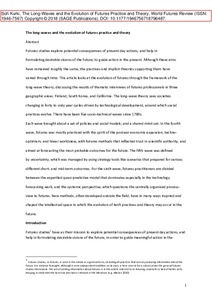The Long-Waves and the Evolution of Futures Practice and Theory
Sofi Kurki
https://urn.fi/URN:NBN:fi-fe2021042720539
Tiivistelmä
Futures studies explore potential consequences of present day actions,
and help in formulating desirable visions of the future, to guide action
in the present. Although these aims have remained roughly the same, the
practices and implicit theories supporting them have varied through
time. This article looks at the evolution of futures through the
framework of the long-wave theory, discussing the results of thematic
interviews of futures professionals in three geographic areas: Finland,
South Korea, and California. The long-wave theory sees societies
changing in forty to sixty year cycles driven by technological
development, around which social practices evolve. There have been five
socio-technical waves since 1780s. Each wave brought about a set of
policies and social models, and a shared mind-set. In the fourth wave,
futures was mostly practiced with the spirit of the postwar economic
expansion, techno-optimism, and linear worldview, with futures methods
that reflected trust in scientific authority, and aimed at forecasting
the most probable outcomes for the future. The fifth wave was defined by
uncertainty, which was managed by using strategy tools like scenarios
that prepared for various different short- and mid-term outcomes. For
the sixth wave, futures practitioners are divided between the expertled
quasi-predictive model that dominates especially in the technology
forecasting work, and the systemic perspective, which questions the
centrally organized process-view to futures. New methods, often
developed outside the field, have in many ways inspired and shaped the
intellectual space in which the evolution of both practices and theory
may occur in the future.
Kokoelmat
- Rinnakkaistallenteet [27094]
